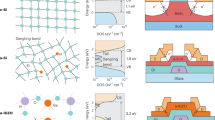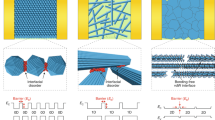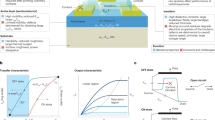Abstract
The use of thin-film transistors in liquid-crystal display applications was commercialized about 30 years ago. The key advantages of thin-film transistor technologies compared with traditional silicon complementary metal–oxide–semiconductor(CMOS) transistors are their ability to be manufactured on large substrates at low-cost per unit area and at low processing temperatures, which allows them to be directly integrated onto a variety of flexible substrates. Here, I discuss the potential of thin-film transistor technologies in the development of low-cost, flexible integrated circuits for applications beyond flat-panel displays, including the Internet of Things and lightweight wearable electronics. Focusing on the relatively mature thin-film transistor technologies that are available in semiconductor fabrication plants today, the different technologies are evaluated in terms of their potential circuit applications and the implications they will have in the design of integrated circuits, from basic logic gates to more complex digital and analogue systems. I also discuss microprocessors and non-silicon, near-field communication tags that can communicate with smartphones, and I propose the concept of a Moore’s law for flexible electronics.
This is a preview of subscription content, access via your institution
Access options
Access Nature and 54 other Nature Portfolio journals
Get Nature+, our best-value online-access subscription
$29.99 / 30 days
cancel any time
Subscribe to this journal
Receive 12 digital issues and online access to articles
$119.00 per year
only $9.92 per issue
Buy this article
- Purchase on Springer Link
- Instant access to full article PDF
Prices may be subject to local taxes which are calculated during checkout




Similar content being viewed by others
References
Kaltenbrunner, M. et al. An ultra-lightweight design for imperceptible plastic electronics. Nature 499, 458–463 (2013).
Fukuda, K. et al. Fully-printed high-performance organic thin-film transistors and circuitry on one-micron-thick polymer films. Nat. Commun. 5, 5147 (2014).
Karaki, N. et al. A flexible 8b asynchronous microprocessor based on low-temperature poly-silicon TFT technology. IEEE Int. Solid-State Circuits Conf. 1, 272–598 (2005).
Wagner, S. & Bauer, S. Materials for stretchable electronics. MRS Bull. 37, 207–213 (2012).
Nomura, K. et al. Room-temperature fabrication of transparent flexible thin-film transistors using amorphous oxide semiconductors. Nature 432, 488–492 (2004).
Street, R. A. Thin-film transistors. Adv. Mater. 21, 2007–2022 (2009).
Fortunato, E., Barquinha, P. & Martins, R. Oxide semiconductor thin-film transistors: a review of recent advances. Adv. Mater. 24, 2945–2986 (2012).
Fortunato, G., Pecora, A. & Maiolo, L. Polysilicon thin-film transistors on polymer substrates. Mater. Sci. Semicond. Process. 15, 627–641 (2012).
Matsuda, S. et al. 30-nm-channel-length c-axis aligned crystalline In-Ga-Zn-O transistors with low off-state leakage current and steep subthreshold characteristics. In Symp. VLSI Technology T216–T217 (2015).
Myny, K. et al. A thin-film microprocessor with inkjet print-programmable memory. Sci. Rep. 4, 7398 (2014).
Heremans, P. et al. Mechanical and electronic properties of thin-film transistors on plastic, and their integration in flexible electronic applications. Adv. Mater. 28, 4266–4282 (2016).
Shulaker, M. M. et al. Carbon nanotube computer. Nature 501, 526–530 (2013).
De Volder, M., Tawfick, S., Baughman, R. & Hart, A. J. Carbon nanotubes: present and future commercial applications. Science 339, 535–539 (2013).
Cao, Q. et al. Medium-scale carbon nanotube thin-film integrated circuits on flexible plastic substrates. Nature 454, 495–500 (2008).
Sun, D.-M., Liu, C., Ren, W.-C. & Cheng, H.-M. A review of carbon nanotube- and graphene-based flexible thin-film transistors. Small 9, 1188–1205 (2013).
Akinwande, D., Petrone, N. & Hone, J. Two-dimensional flexible nanoelectronics. Nat. Commun. 5, 6678 (2014).
Lee, S.-K. et al. All graphene-based thin film transistors on flexible plastic substrates. Nano Lett. 12, 3472–3476 (2012).
Park, S. et al. Extremely high-frequency flexible graphene thin-film transistors. IEEE Electron Device Lett. 37, 512–515 (2016).
Zhu, W. et al. Flexible black phosphorus ambipolar transistors, circuits and AM demodulator. Nano Lett. 15, 1883–1890 (2015).
Das, S., Gulotty, R., Sumant, A. V. & Roelofs, A. All two-dimensional, flexible, transparent, and thinnest thin film transistor. Nano Lett. 14, 2861–2866 (2014).
Yun, J., Cho, K. & Kim, S. Flexible logic circuits composed of chalcogenide-nanocrystal-based thin film transistors. Nanotechnology 21, 235204 (2010).
Mejia, I. et al. Low-temperature hybrid CMOS circuits based on chalcogenides and organic TFTs. IEEE Electron Device Lett. 32, 1086–1088 (2011).
Das, T. et al. Highly flexible hybrid CMOS inverter based on Si nanomembrane and molybdenum disulfide. Small 12, 5720–5727 (2016).
Sirringhaus, H. et al. High-resolution inkjet printing of all-polymer transistor circuits. Science 290, 2123–2126 (2000).
Lee, D.-H., Chang, Y.-J., Herman, G. S. & Chang, C.-H. A general route to printable high-mobility transparent amorphous oxide semiconductors. Adv. Mater. 19, 843–847 (2007).
Arias, A. C. et al. All jet-printed polymer thin-film transistor active-matrix backplanes. Appl. Phys. Lett. 85, 3304–3306 (2004).
Ha, M. et al. Printed, sub-3V digital circuits on plastic from aqueous carbon nanotube inks. ACS Nano 4, 4388–4395 (2010).
Subramanian, V. et al. Progress toward development of all-printed RFID tags: materials, processes, and devices. Proc. IEEE 93, 1330–1338 (2005).
Cho, G. Roll-to-Roll printed 13.56 MHz operated 16-Bit RFID tags and smart RF logos. In Printed Electronics & Photovoltaics Europe (2010).
Bode, D. et al. Noise-margin analysis for organic thin-film complementary technology. IEEE Trans. Electron Devices 57, 201–208 (2010).
Cantatore, E. et al. A 13.56-MHz RFID system based on organic transponders. IEEE J. Solid-St. Circ. 42, 84–92 (2007).
Spijkman, M.-J. et al. Dual-gate thin-film transistors, integrated circuits and sensors. Adv. Mater. 23, 3231–3242 (2011).
Gelinck, G. H. et al. Flexible active-matrix displays and shift registers based on solution-processed organic transistors. Nat. Mater. 3, 106–110 (2004).
Huang, T.-C. et al. Pseudo-CMOS: a design style for low-cost and robust flexible electronics. IEEE Trans. Electron Devices 58, 141–150 (2011).
Raiteri, D., van Lieshout, P., van Roermund, A. & Cantatore, E. Positive-feedback level shifter logic for large-area electronics. IEEE J. Solid-St. Circ. 49, 524–535 (2014).
Venturelli, M. et al. Unipolar differential logic for large-scale integration of flexible aIGZO circuits. IEEE Trans. Circuits Syst. II Express Briefs 64, 565–569 (2017).
Kim, J. S. et al. Dynamic logic circuits using a-IGZO TFTs. IEEE Trans. Electron. Devices 64, 4123–4130 (2017).
Papadopoulos, N. P., Lee, C. H., Tari, A., Wong, W. S. & Sachdev, M. Low-power bootstrapped rail-to-rail logic gates for thin-film applications. J. Disp. Technol. 12, 1539–1546 (2016).
Morosawa, N., Ohshima, Y., Morooka, M., Arai, T. & Sasaoka, T. Novel self-aligned top-gate oxide TFT for AMOLED displays. J. Soc. Inf. Disp. 20, 47 (2012).
Munzenrieder, N. et al. Flexible self-aligned amorphous InGaZnO thin-film transistors with submicrometer channel length and a transit frequency of 135 MHz. IEEE Trans. Electron Devices 60, 2815–2820 (2013).
Myny, K. & Steudel, S. 16.6 flexible thin-film NFC transponder chip exhibiting data rates compatible to ISO NFC standards using self-aligned metal-oxide TFTs. In IEEE Int. Solid-State Circuits Conf. 298–299 (2016).
Yang, B.-D. et al. A transparent logic circuit for RFID tag in a-IGZO TFT technology. ETRI J. 35, 610–616 (2013).
Ozaki, H., Kawamura, T., Wakana, H., Yamazoe, T. & Uchiyama, H. 20µW operation of an a-IGZO TFT-based RFID chip using purely NMOS ‘active’ load logic gates with ultra-low-consumption power. In Symp. VLSI Circuits 54–55 (2011).
Myny, K., Tripathi, A. K., van der Steen, J.-L. & Cobb, B. Flexible thin-film NFC tags. IEEE Commun. Mag. 53, 182–189 (2015).
Hung, M.-H. et al. Ultra low voltage 1-V RFID tag implement in a-IGZO TFT technology on plastic. In IEEE Int. Conf. RFID 193–197 (2017).
Myny, K. et al. 15.2 A flexible ISO14443-A compliant 7.5mW 128b metal-oxide NFC barcode tag with direct clock division circuit from 13.56MHz carrier. In IEEE Int. Solid-State Circuits Conf. 258–259 (2017).
Utsunomiya, S. et al. 21.3: flexible color AM-OLED display fabricated using surface free technology by laser ablation/annealing (SUFTLA) and ink-jet printing technology. SID Symp. Dig. Tech. Pap. 34, 864–867 (2003).
Myny, K. et al. An 8-bit, 40-instructions-per-second organic microprocessor on plastic foil. IEEE J. Solid-St. Circ. 47, 284–291 (2012).
Wachter, S., Polyushkin, D. K., Bethge, O. & Mueller, T. A microprocessor based on a two-dimensional semiconductor. Nat. Commun. 8, 14948 (2017).
Cherupalli, H., Duwe, H., Ye, W., Kumar, R. & Sartori, J. Bespoke processors for applications with ultra-low area and power constraints. In Proc. 44th Ann. Int. Symp. Computer Architecture 41–54 (ACM, 2017).
Garripoli, C. et al. 15.3 an a-IGZO asynchronous delta-sigma modulator on foil achieving up to 43dB SNR and 40dB SNDR in 300Hz bandwidth. In IEEE Int. Solid-State Circuits Conf. 260–261 (2017).
De Roose, F. et al. A thin-film, a-IGZO, 128b SRAM and LPROM matrix with integrated periphery on flexible foil. IEEE J. Solid-St. Circ. 52, 3095–3103 (2017).
Garripoli, C. et al. Analogue frontend amplifiers for bio-potential measurements manufactured with a-IGZO TFTs on flexible substrate. IEEE J. Emerg. Sel. Top. Circuits Syst. 7, 60–70 (2017).
Papadopoulos, N. et al. Flexible selfbiased 66.7nJ/c.s. 6bit 26S/s successive-approximation C-2C ADC with offset cancellation using unipolar metal-oxide TFTs. In IEEE Custom Integrated Circuits Conf. 1–4 (2017).
Pelgrom, M. J. M., Duinmaijer, A. C. J. & Welbers, A. P. G. Matching properties of MOS transistors. IEEE J. Solid-St. Circ. 24, 1433–1439 (1989).
Xiong, W., Guo, Y., Zschieschang, U., Klauk, H. & Murmann, B. A 3-V, 6-bit C-2C digital-to-analog converter using complementary organic thin-film transistors on glass. IEEE J. Solid-St. Circ. 45, 1380–1388 (2010).
Fuketa, H. et al. 1 µm-thickness ultra-flexible and high electrode-density surface electromyogram measurement sheet with 2 V organic transistors for prosthetic hand control. IEEE Trans. Biomed. Circuits Syst. 8, 824–833 (2014).
Harendt, C. et al. Hybrid systems in foil (HySiF) exploiting ultra-thin flexible chips. Solid-St. Electron. 113, 101–108 (2015).
Hassan, M. U. et al. Combining organic and printed electronics in hybrid system in foil (HySiF) based smart skin for robotic applications. In Eur. Microelectronics Packaging Conf. 1–6 (2015).
Ishida, K. et al. Stretchable EMI measurement sheet with 8 x 8 coil array, 2 V organic CMOS decoder, and 0.18µm silicon CMOS LSIs for electric and magnetic field detection. IEEE J. Solid-St. Circ. 45, 249–259 (2010).
Acknowledgements
This work received funding from the European Research Council under the European Union’s Horizon 2020 research and innovation programme under grant agreement no. 716426 (FLICs project). This work was performed in collaboration between Imec and the Netherlands Organisation for Applied Scientific Research (TNO) in the frame of the HOLST Centre. K.M. also acknowledges his co-workers for their valuable contributions to this work.
Author information
Authors and Affiliations
Corresponding author
Ethics declarations
Competing interests
The authors declare no competing financial interests.
Additional information
Publisher’s note: Springer Nature remains neutral with regard to jurisdictional claims in published maps and institutional affiliations.
Rights and permissions
About this article
Cite this article
Myny, K. The development of flexible integrated circuits based on thin-film transistors. Nat Electron 1, 30–39 (2018). https://doi.org/10.1038/s41928-017-0008-6
Received:
Accepted:
Published:
Issue Date:
DOI: https://doi.org/10.1038/s41928-017-0008-6
This article is cited by
-
A detachable interface for stable low-voltage stretchable transistor arrays and high-resolution X-ray imaging
Nature Communications (2024)
-
Mechanically driven assembly of biomimetic 2D-material microtextures with bioinspired multifunctionality
Nano Research (2024)
-
Low Voltage a-IGZO Thin Film Transistor Using Tantalum Oxide by Thermal Oxidation
Electronic Materials Letters (2024)
-
Recent advances in flexible noninvasive electrodes for surface electromyography acquisition
npj Flexible Electronics (2023)
-
Wurtzite and fluorite ferroelectric materials for electronic memory
Nature Nanotechnology (2023)



